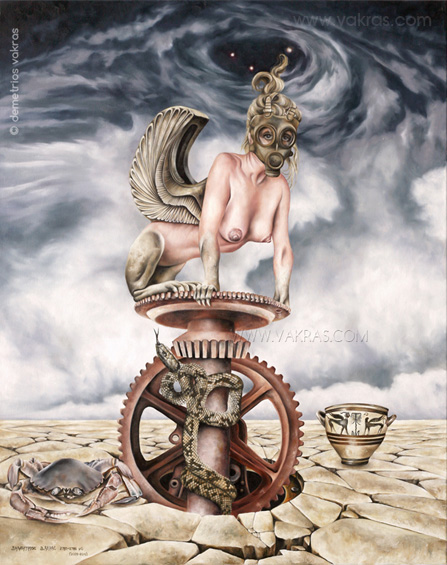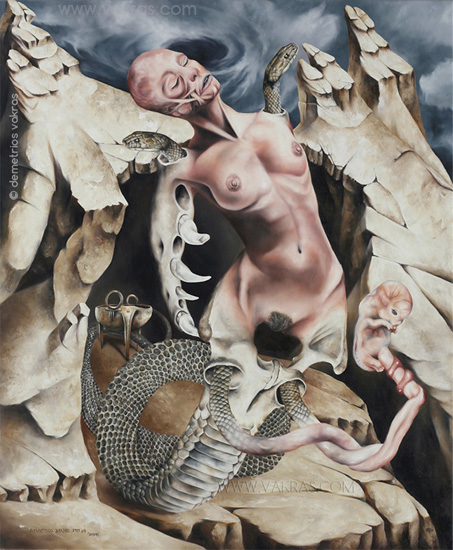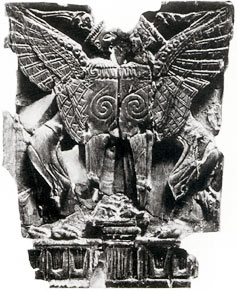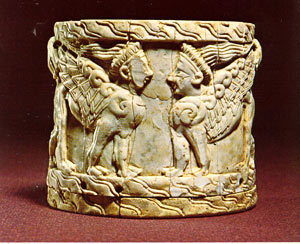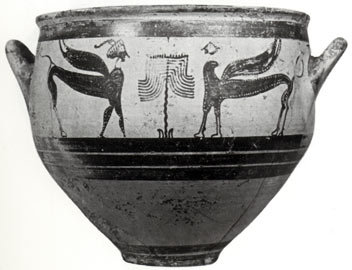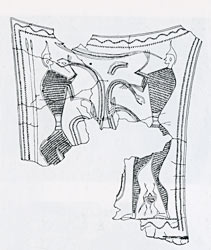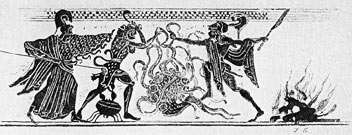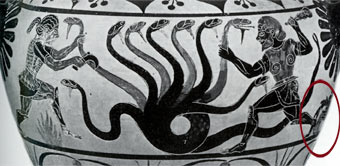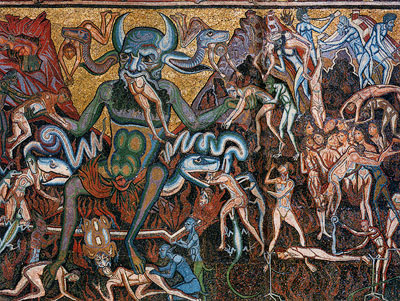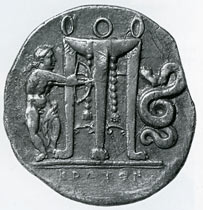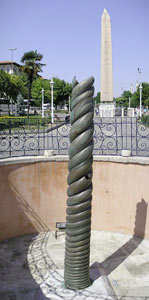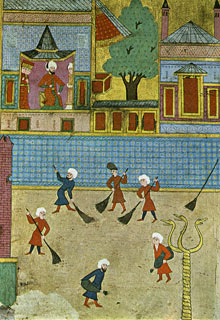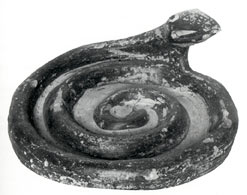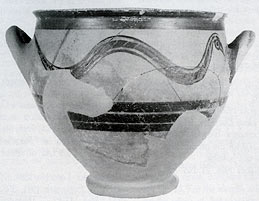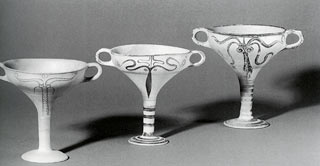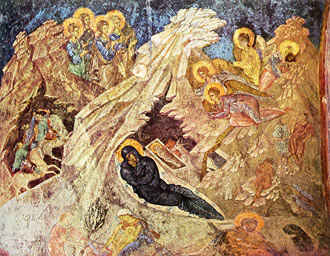© demetrios vakras
Η Σφίγγα και Πυθία
2 drawings from 2008, Sfinx and Pythia [now
replaced by their painted versions
2020]
Σφίγγα and Πυθία – the Mytheic Series of works (Μυθεοικά Έργα).
An explanation of the Μυθεοικά Έργα is in Post Humanist Transhumanist which is available
in print or epub (kindle) from Amazon
The Σφίγγα is the last oil painting I worked on, one decade ago, thanks to the machinations
of the Australian judiciary against whom
I have made a Petition to the UN Human Rights
Commission in Geneva.
Explanatory Essay on the two drawings and their symbology (posted online 13/8/2008; edited 31/8/2008)
Art is the expression by visual means of abstract ideas; that is, thoughts expressed in visual form, which are intended to be shared/communicated with others. The image is thus symbolic, as are symbols which are used to express ideas, such as the alphabet used here to represent ideas (thoughts) as words; and as are numbers used in the expression of mathematical concepts. The selection of objects in my art is deliberate. If art has no idea it is then not art - it might be decorative, it may be therapeutic, but art it is not. This attitude is not a new one. The earliest human art was not decor - it was symbol.
Peoples of antiquity imparted their histories and cosmologies to us in a form to which has been ascribed the Greek word μύθος (mythos/myths). To the word "myth" has been ascribed the meaning of "fable", "invented tale", or "fanciful absurdity" (this is as true in modern Greek as it is in other languages). However, the word itself appears to be directly related to the word "methos" (μηθέος), which is the second part of the name given to the Greek god/sponsor of humanity, "Prometheus" (Προμηθέας). And, his name means "forethought". His brother, Epimetheus, was afterthought, who acting without forethought, had forgotten to equip humankind with the means by which it could survive in the world. Hence Prometheus equipped humankind with fire and technology. (Modern philologists pile error upon error and overlook the obvious.) Mythology then is not a fanciful absurdity, but a kernel of history, or cosmological observation, expressed in a form that was understood by the peoples whose "myths" they were, and who understood "myth" as history. Like visual symbols which are drawn, these "myths" are conceptual symbols. They are not absurd tales of the fanciful.
As art is, or rather should be, the expression of idea by means of symbol, and as is the mythological too, a recounting by way of metaphor (symbol) of idea, I am here incorporating that which is considered myth into my visual repertoire. By so doing I intend to show that the ideas behind the symbols of myth actually stand for something; that is, they are not ridiculous fables. I am appropriating symbols from Christian Byzantine art to illustrate "pagan" ideas, because what is considered "Christian" in the art of the Byzantines, is usually "pagan" symbology appropriated by a religion (Christianity) which was never much more than an intellectual wasteland. When, in Byzantine art, we encounter a depiction of the "Nativity" of Jesus, we find the infant Jesus being depicted in a cave. There is nothing like this mentioned in the Bible. Rather, this is the infant Zevs of Greek (pagan) religion nurtured in the Dictaean Cave. The idea of generation and regeneration inside a cave in the earth is ancient in Greece, and is tied to the worship of snakes, which is evident throughout the entire Balkans as far back as the 6th Millennium BC (if not earlier). This belief in the capacity of snakes to regenerate inside earth is related to a snake's hibernation, inside earth during the winter snows, reappearing again in spring when the snows melt and trees flower. Hence, I depict the Pythia, the serpent who essentially ascends from inside earth to the heavens from the earths navel, the χασμός (chasmos, chasm), in the same cave as that of Zevs-cum-Jesus.
I also represent the sfinx atop a mechanical geared axle. This is intended to represent the axle as the driver of the movements of all the bodies in the heavens, for the Greeks well over 2000 years ago were constructing such mechanical devices to prove that one force (god= Zevs) could account for all motions. I thus intend to show the sfinx as more than a fabulous beast, but as an abstraction of a force, partially anthropomorphised, who guards the polar axis around which, when viewed from earth, the heavens revolve. For, it is not insignificant that Greek sculptures of the Sfinx always show her on top of an ionic column, which with its 4 spirals, symbolises the 4 cardinal points, the extremes of sun-rise and sun-set in summer and in winter (solstices). The axis, like the axle is the point from which all actions are generated.
Hence, the sfinx, atop the world pillar is precisely the being replaced by Christians with their crucifix, symbol of their god Jesus, who is, usually portrayed as the centre around which are the 4 cardinal points in the forms of Matthew (angel), Mark (lion), Luke (ox), and John (eagle).
Additionally, I incorporate into these drawings artefacts rendered faithfully which are intended to show the antiquity of the elements depicted. In one drawing, for instance, I show a Greek pot depicting winged sfinxes guarding a world tree (re, drawing ΣΦΙΓΞ SFINX). Although it is not the earliest depiction of sfinxes in the Greek world, it predates, by around 500 years, the date of the claimed "introduction" of the sfinx into Greece. I intend on exposing in these drawings, if even in a minor way, the enormous deficiencies of contemporary scholarship which with all evidence in contradiction to its conclusions, asserts that the collapse of the "Mycenaeans" resulted in a "Dark Age". An explanation/elaboration of this lies outside the scope of this essay, but will be central to the book, with the working title of Hyperthesis, which I am currently researching.
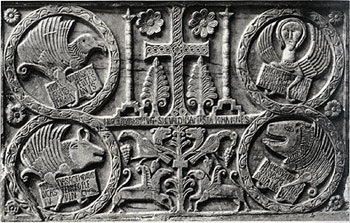 Above: Balustrade relief, c.725-750 AD, inscribed by the Patriarch Sigvald (7622-776 AD). Cathedral Baptistery, Cividale, Italy.
Above: Balustrade relief, c.725-750 AD, inscribed by the Patriarch Sigvald (7622-776 AD). Cathedral Baptistery, Cividale, Italy.
This represents an amalgum of Christian and pagan elements showing the pagan elements alongside those that Christianity has replaced. We have a depiction of the 4 saints, Matthew (angel), Martk (lion), Luke (ox), John (eagle), who mark out the 4-cardinal points. The crucifix, as a representation of the Christian god Jesus, symbolises the the polar axis. So that we do not confuse what the symbol of the crucifix is, we have on either side of it:
A/ a world tree, with its sun-volute (spiral) and;
B/ a pillar (polar axis which extends from the polar void/star to the world navel).
Beneath is represented a more "traditional" (pagan) representation, of the symbolism, that is, the symbols that Christian religion has replaced: the world tree protected by winged griffins and birds/beasts. The world tree, polar axis and crucifix are interchangeable.
The composition can be reduced to the following scheme 8+8, (figure eight, cross, figure eight) that is, two symbols of an eternal loop joined by a cross.
Illus 329, H.W. Janson, A History of Art.
|

On
the Sfinx (web essay):
NOTE: the sfinx of this essay concerns the Greek sfinx ("sphinx"), an aerial anthropotherion (hence its depiction as winged), not the so–called "sphinx" of ancient Egypt which is without wings and, contrary to popular belief, is unrelated.
The sfinx first makes her appearance in Greek Mycenaean art in the 15th/14th century BC. She makes her first appearcance in Greek literature in Hesiod's Theogony (c.700 BC), where she is referred to as the Φικ (or Φικό) "Fik", rather than the more conventional "sfinx". The usual supposition on her origin is that she is from Egypt, and, that like the Egyptian Sphinx, she is said to be a lion-human composite. However, according to Hesiod, her parentage betrays a different lineage to that of Egypt's beast. In the Theogony Hesiod ascribes to her the reptilian/serpentine/snake-nymph Echidna as mother and the two-headed dog-guardian Orthos (himself a son of Echidna) as father. Her snake-mother accounts for her name, "constrictor", sfinx (hence, the Greek-derived English word, "sphincter"). The Greek sfinx is a winged human dog composite - with her dog-body wrongly assumed to be feline. The Egyptian sphinx is wingless and feline. In Egypt the sphinx first acquires wings late in the New Kingdom - and as Herodotus (Histories) notes with surprise, the Egyptian sphinx is masculine unlike the Greek which is feminine. The winged sfinx had already been represented in Greek Mycenaean art before it acquired its wings in Egypt.
Note: the genealogy presented by Hesiod is here far from clear. As D. Wender, translator of the Theogony for Penguin notes, on p.152: "It is impossible to tell whether Hydra or Echidna is the mother here; the ancients were as confused as we are."
H.G. Evelyn-White's translation of the Theogony for the LOEB series reads:
"Echidna was subject in love to Orthos and brought forth the deadly Sphinx..."
(Line 326, Theogony)
|
The Greeks of the mainland worshipped the snake: an underworld snake guarded the world axis at the world's navel, the Pythia; another guarded the axis itself, and the polar void, the Drakon (to be elaborated on); another guarded the perimeter of the world, the Hydra. All of these snakes were "entryway" guardians; that is, they protected entry and exit to the underworld, edge of the world, or through the Χάος (Chaos), the void at the apex of the sky (Unlike the people of the Near East who had as such guardians "scorpion-men"). For the Greeks snake guardians were generally underworld guardians (except Drakon). Overworld guardians were generally represented as birds (hence a winged figure is an overworld figure). The sfinx's mother may have been a serpent of the underworld, but her guardianship was in the overworld - hence she is not represented with her maternal attributes. She is a winged dog anthropomorphised, whose serpentine heritage is preserved in her name alone.
As for her parentage, part serpent, part dog, it is the means by which alternate cosmologies are reconciled. In other words: at some stage a people whose cosmologies placed dog-guards at the passageways to the "otherworld" entered the Greek mainland where they became merged with the serpent-guards of the indigenous peoples of the Greek mainland. As her representation is completely developed in Mycenaean representations, this reconciliation must have occurred some time earlier.
THE MYCENAEAN PERIOD SFINX
|
|
|
|
|
Top left: Heraldically opposed sfinxes, Ivory relief. From the "House of Sfinxes", Mycenae. Ascribed to c. 1300-1200 BC. Illus. 162, Higgins, Minoan and Mycenaean Art. Pl. 97, Taylour, The Mycenaeans.
Top right: Ivory pyxis from a chamber tomb of Thebes, 13th century B.C.
Archaeological Museum of Thebes
Left: Vase with "confronting" winged sfinxes guarding world tree. Ascribed to 13th century BC, Enkomi, Cyprus. Illus. 134, Higgins, Minoan and Mycenaean Art. This vase appears at the bottom right of my drawing sfinx.
|
THE CLASSICAL PERIOD SFINX
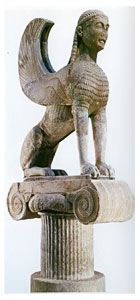 The sfinx from Naxos (above), c.570 BC. Illus. p. 68, The Emergence of Greece, A. Johnston.
The sfinx from Naxos (above), c.570 BC. Illus. p. 68, The Emergence of Greece, A. Johnston.
The wings on my drawing sfinx are from this sculpture.
|
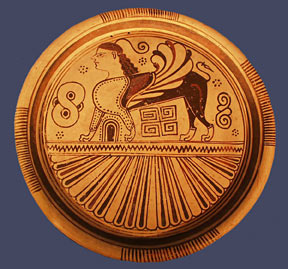 Plate from Rhodes with a winged female sphinx in a patterned field (above), c. 600 BC. http://www.beazley.ox.ac.uk/CVA/Projectpages/CVA6.5.2.htm
Plate from Rhodes with a winged female sphinx in a patterned field (above), c. 600 BC. http://www.beazley.ox.ac.uk/CVA/Projectpages/CVA6.5.2.htm
Ashmolean Museum 1885.634
|
The sfinx, as is evident, makes her appearance in Greece during the Mycenaean period and she continues to be represented on vases, reliefs and sculptures from then on. One of the great curiosities of contemporary scholarship is the conclusion formed on faulty chronologies that the collapse of Mycenaean Greece saw the plunge into a prolonged 400 year dark age of the Greek peninsula. In the context of this claim, the appearance of the sfinx in Classical Greece has been ascribed to a claimed "orientalising" period. This claim has it, that the Greeks had forgotten their achievements, and selectively chose, 400 years later, only those elements which had previously been Mycenaean from the peoples of the Levant who had preserved for the Greeks their Mycenaean heritage, and that from these selective acquisitions the Greeks created a new civilization, that of Classical Greece. A similar fate is claimed to have befallen the griffin, and Linear B the script in which Mycenaeans wrote Greek.
(Briefly: The griffin first appears on pre-eruption Thera, on Krete, and on the Greek mainland. According to contemporary historians it disappeared for around 400 years from all of these regions. In the meantime, the assertion goes, it had been saved by the peoples of the Levant, and it was from the Levant that the Classical Greeks acquired it. In another example, that of the of Linear B script used by Mycenaeans to write Greek, it too disappeared. Somehow, it lay dormant for a period of 400 years also, but reappeared - miraculously - on the island of Kypros - Cyprus. It was used to write Greek on that island until the 3rd century BC and was used alongside the alphabet of classical Greece to write the Greek language. The list of lost Mycenaean ideas which, like the womb of Semele are claimed to have been preserved elsewhere is very long. What never ceases to amaze is that the classical Greeks - if we accept the claim - selectively chose only those elements which had previously been Mycenaean. A link to my page with a short discussion of the Griffin can be found here. At the moment I am researching a book, which with the title Hyperthesis, covers this phenomenon to expose the faulty logic which posits a "Dark Age" in a chapter entitled "Preservation of the womb of Semele".)
In my drawing I place my sfinx on a pillar (which is a modified, geared, device - which I have unfortunately drawn a little off-centre). Her representation in Classical Greek sculpture usually places her atop a pillar (although on vases she usually appears in confronted pairs protecting an anthemion-design, that is, a stylised world-tree). She is its guardian. In alternate representations, such as the plate from Rhodes, she strides over a gap. This could possibly be the earth's navel, or the polar void. As she is winged which symbolises her as a sky guardian, then the latter has to be correct. In my drawing the sky above her head represents the polar void, the Χαός "Chaos" of the Greeks. (Both Greeks and Germans/Norse share the idea of the cosmic gap. In the Norse tradition it is known as the Ginnungagap: OpenVoid). In my drawing the gap, χαός, has at its perimeter 3 stars, or rather, 3 circumpolar stars. The direction that the earth's axis points to changes in time. This axis has a "wobble" which takes approximately 26000 years to complete. This "wobble" is known as precession (Precession of the Equinoxes). At the moment the world's northern celestial pole has at its apex the "northern star"/"pole star", (polaris) alpha Ursae Minoris. This was not always so. At around 3000 BC the pole star was alpha Draconis, at the time of Classical Greece it was beta Ursae Minoris. At the time of the Mycenaeans there was a void. Around this void circled circumpolar stars. In Hesiod's Theogony are described the 3 Kyklopes (Cyclopes), "round eyes". Hesiod in his Theogony writes " the Cyclopes, overbrearing in spirit, Brontes, and Steropes and stubborn-hearted Arges who gave Zeus the thunder and made the thunderbolt" (Theogony 136-141, Evelyn-White translation). Their names mean "thunderer", "flash" and "bolt". When considered in this context, it explains why Zeus is the αστερπητής, "star-hurler" in Homer's Iliad (c.750 BC). (The example here is from the Iliad 12.275. Modern Greek renditions alter this to αστραπηβόλος which means "lightning projectile". Lattimore's translation into English misses the mark completely by translating it as "thunderbolt"). These 3 "round-eyes" essentially trace by their movement an eye in the sky and garner the energy of the light of stars which they fashion into the weapon of Zeus. Lightning is therefore by this means concentrated star-light. Zeus is not, as modern analysts claim, a simple "storm-god".
Though, as I have pointed out, the sfinx is partially serpentine, the snake which appears in my drawing is intended to represent the Πυθία (Pythia) the serpent centered at Delphi which Greek myth says was killed by Apollon. (In Greek Apollon - Απόλλον hence Απ` πόλον - means "from the pole", though the Pythagoreans who should have known better speculated that it meant one god "from the many". However, the word pole in Greek is πόλος "polos", the Greek word for "from" is από "apo". The only point at which the Pythagoreans and I agree is that the first part is intend to mean "from". The Pythagoreans had a disposition to fanciful inventions. The observable - phenomena - were for example, made to fit into their ideology. Hence, to reconcile the cosmos with their idea of 10 as a holy number they invented a "counter-earth", invisible to us because it is conveniently always on the other side of he sun). So my Pythia, the serpent clings to the pillar/pole, the world axis. She comes out of a hole in the earth - this is the world navel, the χασμός "chasm": where (all) is lost. The pillar on which she sits is always (as far as I am aware) an "Ionic" pillar. The Ionic pillar always has 4 spirals which are not, as some modern authors contend, "scrolls", but spirals representing the sun's passage into and out of the winter and summer solstices. Hence, the Sfinx sits atop the polar axis around which the heavens revolve and which governs the movement of the sun's seasonal path along the ecliptic.
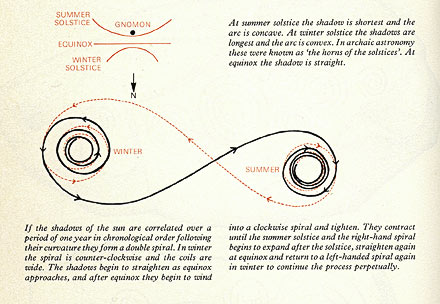 Why the sun came to be symbolised by a spiral can be shown by the illustration above.
Why the sun came to be symbolised by a spiral can be shown by the illustration above.
"American artist, Charles Ross, arrived at a double spiral in a controlled experiment documenting the sun's path through the year. Using a stationary focused magnifying glass, he placed wooden planks in a fixed position for 366 consecutive days. The sun's rays burned a pattern in the planks which when graphed showed a precisely executed double spiral.", p.190, M. Brennan, The Stars and the Stones - ancient art and astronomy in ancient Ireland.
The Greeks also rendered the sun-spiral in an angular form: the swastika. A swastika is shown in the plate from Rhodes above.
|
The crab that lies to the left of my drawing is the crab which Hera sent to attack Herakles when he killed the Hydra.
The killing of the Laernaean Hydra by Herakles and Iolaos, lines 313-317 of Hesiod's Theogony, neither mentions the crab nor the multi-headed nature of the Hydra. The crab and the multi-headed Hydra are both represented in Greek art from at least the 8th century BC which means that the tale predates Hesiod and is contemporary with Homer, although the aspect of the attack of Herakles by the crab was not written on until some time later.
|
|
|
|
|
Above left: Herakles and Iolaos fighting the Hydra, from a bronze fibula plate from Boeotia dating to the end of the 8th century BC. The crab was, according to mythology sent by Hera to attack Herakles when he attacked the Hydra. As noted by Ptolemy in his Tetrabiblos, the crab was the last moon-sign (in the zodiac) before the solstice. It was followed by the lion (Leo), whose pelt (and hence on whose behalf) Herakles had killed the Hydra. According to this interpretation, the zodiac was in existence in Greece over 200 years earlier than the date ascribed for its development in Babylon. Illus. 178, Art and Myth in Ancient Greece, T. H. Carpenter
Above right: Herakles and Iolaos fight the Hydra. Herakles is identified by his lion's pelt and by the crab attacking him. Illus. 270, Athenian black Figure Vases, J. Boardman. Louvre, drawing after Perrot-Chpiez, Historie de l' Art x 689.
Left: Herakles and Iolaos attack the Hydra. Herakles wielding the club is attacked by the crab (circled right). Caeretan hydria, c. 530 BC. Getty Museum. Illus. 180, Art and Myth in Ancient Greece, T. H. Carpenter
|
Herakles is the displacer of a 9-house (or 8-house) zodiac replacing it with an Egyptian derived 12-house zodiac (The zodiac division into 12 is Egyptian, not Babylonian, and is derived from the division of the year into 12 moon-cycles by the Egyptians which were governed by the yearly passage of the rising and setting sun across the horizon. This system was appropriated by the Greeks who replaced the sun with planetary deities). Herakles’ first labour is the killing of the Hydra from Lerna. According to the tale, the Hydra had nine heads: 8 were immortal, whilst the 9th was mortal. According to the myth Hera sent a crab to attack Herakles which he kicked. The interest of the crab lies in that it is the final zodiac sign before the equinox. It is a symbol (as is described in Ptolemy’s Tetrabiblos) of the moon. The next zodiac sign is the lion. It is the first sign after the equinox, and it is a solar sign (again, according to Ptolemy in the Tetrabiblos). The lion is the beast whose hide Herakles wears. Herakles overthrows the moon and takes over the role of the sun. The Greeks have, in this myth, deposed a lunar system and taken up a system dominated by the Egyptian Ra (sun), & then deposed Ra (in the guise of the lion), whose hide Herakles wears, whilst keeping the 12 month division of the Egyptian solar year. Herakles is a master of time. And the crab is then a symbol of the zodiac. This brings us to the geared "pole" around which is entwined the python atop which sits the sfinx. This is a representation of the Antikythera mechanism.
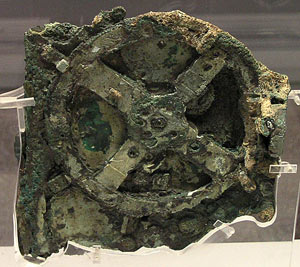 Above: one of the fragments of the Antikythera Mechanism. It is displayed at the Athens Museum. Source: http://en.wikipedia.org/wiki/Antikythera_mechanism
Above: one of the fragments of the Antikythera Mechanism. It is displayed at the Athens Museum. Source: http://en.wikipedia.org/wiki/Antikythera_mechanism
|
The Roman Cicero writes on the machines of the Greeks in both his On the Nature of the Gods and in his The Republic.
Here I quote Cicero's description of one of the two globes of Archimedes which the general Marcellus had taken as loot in the sack of Syracuse:
"that other globe, which was solid throughout, was an ancient invention; it had first been turned on the lathe by Thales of Miletus; then it was marked by Eudoxus of Cnidus, reputedly a pupil of Plato's, with the constellations and stars which are fixed in the sky.... This newer type of globe, however, displaying the movements of the sun and moon and of the five stars which are called wanderers or 'planets', could not be fitted onto the earlier, solid globe. Archimedes' invention was amazing in that he had worked out how a single rotation could reproduce the diverse paths of the various bodies with their different speeds. When Gallus operated this sphere the result was that the moon was as many revolutions behind the sun on that brass contraption as it was days behind it in the sky. Hence the very same eclipse of the sun took place in the sky and on the globe..." Cicero, The Republic, Book One, 22. N. Rudd translation.
The "Antikythera Mechanism" is the earliest discovered cosmological mechanical device of he Greeks. Until its accidental discovery in the early 20th century, it had been assumed that Cicero was exaggerating in his descriptions of such devices. The representation of the cosmos however, as an orderly construct which can be simulated by mechanical devices and understood because it is governed by reason - λόγος, logos - is solely based upon the Greek religious belief that Zeus imposed order on disorder, that he imposed reason, logos, and by means of logos, laws which govern all existence. The representation of the cosmos by a device in which one movement causes a multiplicity of movements and hence explains the cosmos forms the origin of modern science but is born of Greek religion. It was the Greek idea of a rational god who created a rational cosmos, which because it was rational could be understood by humanity with the application of reason, which produced the Antikythera Mechanism.
My Sfinx then sits atop the pillar of knowledge which has been arrived at by the application of reason. In the religion that was to follow, the neo-Judaism of Christianity, the god it preached was one that it demanded should be accepted on the irrational basis of "faith":
"By faith we understand that the universe was formed at God's command, so that what is seen was not made of what was visible." Hebrews 11.3.
The rational basis of Greek ("pagan") religion was seen as evil and was condemned :
“‘I will destroy the wisdom of the wise; the intelligence of the intelligent I will frustrate.’ Where is the wise man? Where is the scholar? Where is the philosopher of this age? Has God not made foolish the wisdom of the world? ... Jews demand miraculous signs and Greeks look for wisdom, but we preach Christ crucified... “ 1 Corinthians 1.19-23
“...the wisdom of this world is foolishness in God’s sight... The Lord knows that the thoughts of the wise are futile.” 1 Corinthians 3.19-20
“... ‘wisdom’ does not come down from heaven but is earthly, unspiritual, of the devil.” James 3.15.
The Christian pseudosophy then appropriated a garbled version of the religion of the Greeks to assert that their god could be defined in a Greek manner:
"In the beginning was the Word, and the Word was with God, and the word was God [John 1.1]...The Word became flesh and lived among us [John 1.14]", New Testament, Book of John.
(**** All Biblical quotes are from the New International Version translation.)
The word used for "word" is the Greek λόγος (logos). The word logos has several nuances in Greek. It is the word logic (reason), as much as it is literally the spoken/written word. It is a Greek, non-Jewish idea.
In the Greek east, vestiges of Greek religion are syncretised with Christianity. In Byzantine depictions of the "Nativity of Christ", the 3 Kyklopes appear in the form of the three fingers of the hand of god, giving Zeus, in the guise of Jesus in the manger, his lightning weapon, whilst he is being nurtured in the Dictaean Cave.
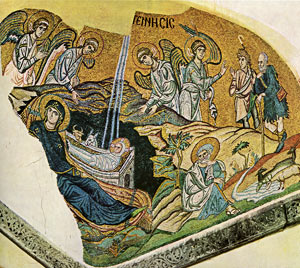 Above: The nativity, c. 1100 AD, Daphni, Greece. Mosaic in the Nave of the church.
Above: The nativity, c. 1100 AD, Daphni, Greece. Mosaic in the Nave of the church.
Three "rays" are emanating from the χαός Chaos (gap) in the sky and shine a light to the world's navel within which Jesus is nurtured.
However, what is represented here is the nurturing of Zeus in the Dictean Cave in Krete. Zeus changed his nurses into bears, the constellations of Ursa Major and Ursa Minor, who guard the polar axis. This mosaic makes no sense in a Jewish context, but is entirely explicable only in the context of Greek thought. Illus., p.117, Byzantine Painting, André Grabar.
|
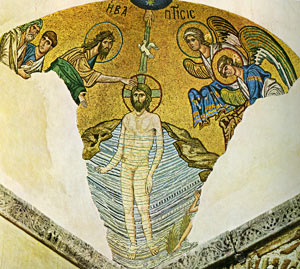 Above: Baptism of Christ, c. 1100 AD, Daphni, Greece. Mosaic in the Nave of the church.
Above: Baptism of Christ, c. 1100 AD, Daphni, Greece. Mosaic in the Nave of the church.
It shows the hole-in-the-sky, the Chaos of the Greeks, Ginnungagap of the Norse. Within the gap is an 8-point star, Venus (Venus is always associated with the number 8. In the Venus cycle of 8 years, Venus appears as the morning star 5 times and divides the zodiac into a pentagram, p. 18 Sacred Number and the origins of civilization, R. Heath). From within the gap appears the hand of god which has extended the 3-fingers used to symbolise the father, son and holy spirit by Orthodox Christians. Its energy is shown by 3-lines extending from the fingers to the figure of Jesus. The power of 3 from the gap is none other than the 3 Kyklopes ("cyclopes") of Greek Mythology, Brontes, Steropes and Arges from Hesiod's Theogony. The hand of God indicates a pole from the void to the Navel of the earth (which was believed by the Greeks of antiquity to lie at Delphi). Illus., p. Byzantine Painting, André Grabar.
|
The new Παρθενιά
(Parthenia):
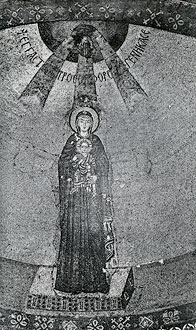
Above: The "mother of god" mosaic, dating to after the iconoclastic period, 843 AD. From the Church of the Assumption of the Virgin at Nicea. Destroyed by the Turks in 1922 AD. Illus. 78, Art of the Byzantine Era, D Talbot-Rice.
Three beams radiate from the hole at the apex of the sky onto the Parthenia. Parthenia (παρθενιά), meaning virgin, was the epithet of Athena, hence her temple the Parthenon. Her temple in Athens was converted into a temple for the new "virgin", Mary.
|
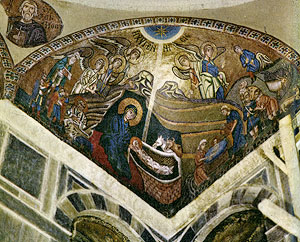 Above: Mosaic from the Monastery Church of Hosios Lukas, 1000 AD, Near Daphni. Illus. 79, Art of the Byzantine Era, D Talbot-Rice.
Above: Mosaic from the Monastery Church of Hosios Lukas, 1000 AD, Near Daphni. Illus. 79, Art of the Byzantine Era, D Talbot-Rice.
The Parthenia with baby is overseen by 5 angels, who are none other than the 5 planets, the gods who are about to be usurped by the neo-Judaic faith. Only 5 planets can be seen with the unaided eye: Mercury and Venus (between the earth and sun), followed by Mars, Jupiter, and Saturn. The star with 8 points is Athena's star (the explanation for which lies outside the scope of this essay).
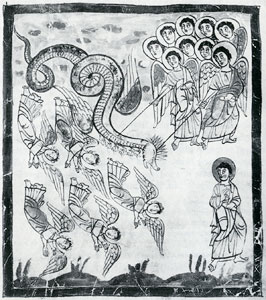
Above: 5 "'Falling Rebel Angels, with the Devil as a dragon', from the Trier Apocalypse, c. 800-820 AD. Stadtbibliotek (MS 31 fol. 38r), Trier." Illus. 71, The Devil: the archfiend in art from the sixth to the sixteenth century. Luther Link.
The pagan symbolism is unmistakable. The number of "good angels" is 9, the northern European (pagan) holy number. The falling angels number 5, the number of planets replaced by the neo-Judaic faith. The Hydra, garbled in the neo-Judaic "holy book", is given 7 heads and killed:
"another sign appeared in heaven: an enormous red dragon
with seven heads and ten horns and
seven crowns on his heads. His tail
swept a third of the stars out of the
sky and flung them to the earth
...Michael and his angels fought
the dragon...The great
dragon was hurled down - that
ancient serpent called the devil or
Satan, who leads the whole world
astray. He was hurled to the earth,
and his angels with him."
NT, Revelations 12.3-9
The 5 angels representing the 5 planets which stand as guardians over the new god in Byzantine depictions are shown by northern artists as "fallen angels".
|
Greek, "pagan" ideas, serve as the prism through which Christianity was understood and interpreted in the (Greek) east, which unlike the (Latin) west was not cursed by Augustine and his diatribe "against the pagans" which
so poisoned the minds of western Christians.
(Saint) Augustine's influential work "Concerning the City of God against the Pagans" is an attack against "paganism", specifically Greek religion. Augustine was born in 354 AD. In the Greek east a figure of as great an influence as Augustine was his contemporary Saint Basil born in 330 AD. (Saint) Basil's book, Προς τους Νέους, όπως αν εξ? Ελληνικών ωφελοίντο λόγων ( "For the youth, on reading pagan literature")
was to exert a huge influence in the east. Basil taught that pagan
knowledge was of benefit. His book was to have an enormous influence
in Italy during the renaissance when it was translated from the
Greek.
(The translation of Basil's book in
English can be found in the Loeb series. It is no. 270, ISBN 0674992989.
The title to his essay is usually translated as an "address to young men", because Basil has used the masculine form in the plural for "youth",
τους νέους. However, it would have been written the same if the
intention of Basil was that all youth regardless of gender would
gain benefit.)
Note: in the Greek language the word "pagan" is not used. The Greeks used the word for "Greek" (Ελληνες - Hellenes) to denote "pagan", and thus referred to themselves as "Romans",
and therefore Christians. Basil's advice is about Ελληνικών (Hellenikon),
Greek, therefore pagan literature.
The chasm between east and west was unbridgeable. In the west pope Gregory ("the great") wrote a famous letter condemning Bishop Desiderius of Cahors for lecturing on classical texts (p.3, Carolingian Culture: emulation and innovation, Ch. 1, Introduction, G. Brown). In the east patriarch Photios wrote a short commentary on Apollodorus' Library of Greek Mythology: "It contained the most ancient stories of the Greeks ["pagans"]: all that time has given them to believe about the gods and heroes...it is a general summary which is by no means lacking in usefulness to those who attach some value to the memory of the ancient stories." (p. viii, introduction to translation of Apollodorus' Library, R. Hard.)
|
|
Left: Judgement Day. A giant devil with snakes emerging from his ears, and sitting on a two-headed snake seat devours the souls of sinners. Hell, and damnation are depicted at the entryway to Hell: a cave.
This is the same cave in which the Byzantines depicted the Nativity of the god both Orthodox and Catholic(-cum-Protestant) Christians share. Instead of their shared god emerging from the cave his adversary and anti-thesis does! There is a chasm in the culture of east and west Europe.
13th century AD, mosaic in the cupola of the (octagonal) Baptistry in Florence. Illus., pp. 38-39, Biblical Archaeology Review May/June 2006 Vol. 32 No. 3.
|
On
the Pythia:
My
next drawing is the Pythia. In Greek myth her lair is at the
earth's navel which is located in Delphi. And,
according to Greeks, she binds
every living being to the cosmos. It is by her, the Pythia from
Delphi, that biological relationships
in Greek are understood and are
so referred to as Delphian. In Greek, the word "sibling" is "adelphia" (ie philadelphia, the love of a sibling), that is, "from Delphi". Located at the world navel the Pythia is then a cosmic umbilicus.
The earliest mention in Greek literature of the Pythia occurs in Homer's mention of the prophetess of her oracle. In the Iliad her oracle (prophetess) is described as the "Pytho of the Rocks" in the service of Apollon. In the Odyssey is described her oracle's capacity to prophesy by way of Apollon making his utterances known by having them spoken through her which shows that her attributes were firmly established by the time of Homer. The tale of the Pythia in the form of the snake first appears in the Homerica, the cycle of poems which in antiquity were attributed to Homer. The composition of these poems are now attributed to various authors other than Homer and ascribed largely to the 7th century BC. In the Ode to the Pythian Apollo, the god Apollon kills the Pythia, who according to this poem nurtured the monster Typhon who so nearly destroyed the cosmos. (This genealogy ascribed to Typhon is in conflict with that given by Hesiod and other Greek authors). After killing her,
"Apollo boasted over her:
'Now rot here upon the soil that feeds man...
here shall the Earth and shining Hyperion make you rot..'
And the holy strength of Helios made her rot away there; wherefore the
place is now Pytho, and men call the lord
Apollo by another name, Pythian; because on that
spot the power of Helios made the monster rot away."
lines 362-375, Evelyn-White translation.
By killing the Pythia Apollon acquired his powers of prophecy born of the underworld - in his northern guise Apollon is none other than Odin (but that is another essay).
|
|
|
|
|
Above left: Apollon attacking the Python at Delphi. Silver stater from Kroton, c. 420 BC. Illus. 104, Art and Myth in Ancient Greece, T. H. Carpenter
Above right: Remnants of Serpent column, Constantinople. http://en.wikipedia.org/wiki/Image:Snake_column_Hippodrome_Constantinople_2007.jpg
The serpent column was set up in Delphi on behalf of the Pythia. Its stone base has been located at Delphi. It was still there when visited by Pausanias in the 2nd century AD when he describes the gold tripod placed on the top of the "bronze snake" (Book X, 13.4). The serpent pillar was taken by Constantine to the city he renamed after himself and was placed in front of the original Hagia Sophia. It was later moved to the Hippodrome. It survives, though much mutilated (its heads are missing) in Constantinople now called "Istanbul" by the Turks. (The Arab author Al-Ma'udi wrote on the name by which the Arabs referred to Constantinople: "The Rum call it 'bolin' [πόλις, polis, that is, "city"], and when they wish to express its greatness as the capital of the empire, they say 'estin bolin'. The Rum do not call it al-Kustantiniyya; only the Arabs do so." From Byzantium Viewed by the Arabs, N. M. el Cheikh. It is evident that Al-Ma'udi did not know Greek. The term "estin bolin" is a rendition of the Greek "εις την πόλιν", "to the city" and is not a means by which the city's greatness is expressed. The Turks renamed the city of Constantine in order to stamp their ownership over it, to make it Turkish, by giving it ... a Greek name. For Byzantiine authors Constantinople is often referred to as "the city" - footnote p. 6 The Chronicle of Theophanes, translated by H. Turtledove.)
Left: Sweepers at the Hippodrome, with the Serpent Column in the foreground. From the Surnama of Murad III (1574-95). Illus. 212 Islamic Art, D. Talbot-Rice. Nearly 150 years after the conquest of Constantinople by the Turks, the "serpent pillar" was still intact.
|
The killing of Pythia by Apollon is depicted in Greek art. Examples include the coin pictured above. And, the representation of her always include the tripod dedicated to her. To understand her significance and the relevance she had, she must be understood both in the context of the Ode to the Pythian Apollon, and in the context of snake behaviour. There is a contemporary misunderstanding of the significance of the snake derived in the main from Judaic misconceptions. For the Greeks the snake was a symbol of fertility. Sigmund Freud made a claim that the association of the snake with fertility was because to him the snake's head has a similar appearance to a circumcised penis. This is way off the mark. My explanation on why snakes were believed to be symbols of fertility (taken from this online page):
The association of the snake with fertility is predicated on the physiology of all snakes. Being ectotherms their temperature is is dependent on external sources. In Europe, snakes withdraw into underground retreats, hibernacula, in the colder months and enter into a period of hibernation for the duration of winter and so are entirely absent. This however is not necessary for snakes in the Near East. Indeed in hot climates, such as deserts, snakes seek protection from the sun during the hottest part of the day and in extreme cases withdraw underground for up to several weeks in a process known as aestivation. The association of snakes with fertility is a European association, made because snakes erupt out of earth at the same time that plants and crops flowers. What dies it is believed, is regenerated when buried inside earth like a flower, or a snake.
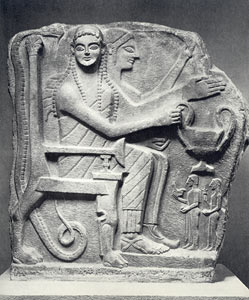 "Heroized" Dead, marble relief. Spartan mid 6th century BC from Chrysapha. State Museum Berlin. Illus. p. 99, Art of Crete, Mycenae , and Greece, German Hafner.
"Heroized" Dead, marble relief. Spartan mid 6th century BC from Chrysapha. State Museum Berlin. Illus. p. 99, Art of Crete, Mycenae , and Greece, German Hafner.
The snake, far from being a malevolent fiend, is a protector of the dead in Hades. It is the opinion of many scholars that depictions of snakes in this manner are "apotropaic", talismans intended to frighten away evil. Though the snake is evil for Zoroastrians and Jews, it was not for Greeks. The significance of a snake being represented with the dead has to be understood in the context of its believed powers of regeneration from the state of being dead: the snake hibernating in the earth during winter, in a dead-like state, can "regenerate" itself. Snakes then, are believed to have the power to re-animate the dead.
|
|
|
|
|
|
Above left: Coiled clay snake from the "Room of the Idols", from the cult centre of Mycenae. Illus. 150, Taylour, The Mycenaeans. This is 1 of 17 such coiled snakes found at the cult centre, (p. 157, Schofield, The Mycenaeans.)
Above right: Mycenaean bowl with snakes LH IIIC Early. c. 1300 BC (?)
Illus. 250, Sakellarakis, The Mycenaean Pictorial Style In the National Archaeological Museum, Athens. Inv. No. 2775, prov. Mycenae. National Archaeological Museum, Athens
Left: Kylikes, stemmed goblets. These are found smashed at Mycenaean graves "presumably from a funerary drinking custom". Illus. 113, The Mycenaeans, L. Schofield.
Snakes have a long history in the Balkans. Above are 2 Mycenaean depictions. Mycenaeans usually depict birds, horses, bulls, chariots. Snakes are rare. The depiction of the Kylikes, left, would seem to be a curious inclusion. In a recent essay by Jerome Y Lettvin entitled "The Gorgon's Eye", pp. 133 -151 from Astronomy of the Ancients, Lettvin provides a compelling case that the Medousa of Greek myth is an octopus. This would concur with the kylikes found in Mycenaean tombs, and would show that it is a tale from the Mycenaean period.
In Greek mythology Herakles kills the 9-headed Hydra, who with 8 immortal heads (which regenerate), and one mortal head (which will kill the beast outright) is an octopus with 8 arms which regenerate and a "mortal head". The 9-headed Hydra then, is an octapod which has been re-cast as a serpent some time between the collapse of Mycenae and the rise of Classical Greek civilization.
(The "Mycenaean period" is given the dates of c. 1600 - c. 1050 BC).
A longer discussion on snakes:
http://www.daimonas.com/pages/snake-worship.html
|
In my drawing titled Pythia, my Pythia, like the serpent pillar is composed of 3 entwined snakes. She is a snake, and from her, one part of her comprised of 2 snake's tails, becomes entwined and merges to become an umbilicus that has at its end a foetus. My Pythia is presented as a "yoke" which couples the genders and brings about life. This idea of a yoke is usually associated with Zeus (see Minoan seal below).
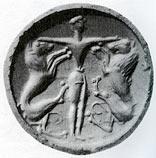 Above: "Lord of the wild beasts". Minoan seal from Kydonia. Oxford, Ashmolean Museum. Illus. 25, Dionysos, archetypal image of indestructible life, C. Kerényi.
Above: "Lord of the wild beasts". Minoan seal from Kydonia. Oxford, Ashmolean Museum. Illus. 25, Dionysos, archetypal image of indestructible life, C. Kerényi.
The seal above shows a god, not as master as is generally supposed, but as the yoke/invisible bond. The god depicted is most likely Zeus. His name in Greek, Ζευς, Zevs, forms the root for the word "yoke"/ "paired". However, contrary to translations into English, his appearance in Greek literature is uncommon in the form "Zeus". He is most commonly referred to as Διός (Dios, "the Two"), and less commonly as Zevs or Ζηνός (Zénos, "the living"). All epithets allude to an association of Zeus with fertility, the invisible yoke which bonds the 2 genders which results in new life.
He first appears in Linear B tablets in the form of "Diwios". In this form his name includes a so-called "digamma", or "w" sound which exists in some, not all, Greek dialects of antiquity. Thus, Dios and Diwios are the same. Modern philologist claim that these were two different concepts, and that they derive from separate so-called "Indo-European" roots. Although the philological fantasies that constitute the orthodox scholarly position lie outside the scope of this essay, I will provide a reference to the orthodox position as it appeared on the wikipedia (in 2006):
• *Dyeøus Ph2ter is believed to have been the original name of god of the daylit sky and the chief god of the Indo-European pantheon. He survives in Greek Zeus [ZEVS](also Dias [Dios]),
• [From the wikipedia]
http://en.wikipedia.org/wiki/Proto-Indo-European_religion
Also:
http://en.wikipedia.org/wiki/Deus
Deus
From Wikipedia, the free encyclopediaDeus (pronounced ['deːus]) is the Latin word for "god" or "deity". The Latin words deus and dīvus, and Greek δι?ος = "divine", are descended from Proto-Indo-European *deiwos = "divine", from the same root as Dyēus, the reconstructed chief god of the Proto-Indo-European pantheon, also a cognate of the Greek Ζευς (Zeus).
:
It begs the question: why is the word "god" used instead by germans?
|
|
My Pythia is also drawn in a state of decomposition, hence her face is partially
decayed and her snake body evolves from exo-skeletal components
which are intended to show her potential for decomposition.
In her capacity to regenerate, she is responsible for life
generating from death. She evolves from a cave, the "Chasm" from which her oracle (priestess/prophetess) would inhale the fumes and intoxicated with wisdom, make a prophetic utterances. In Greek the term for intoxication is the same as used for knowledge (as in its use in the name Prometheus, as discussed earlier). The cave that I have as my Pythia's lair is one that
appears in Byzantine art which though neo-Judaist (Christian)
used motifs from what were considered to be fables from a past
when false gods were worshipped, to depict their god. This cave,
a representation of which already appears earlier in this essay,
is used by Greek Christians, who through the prism of their
ancestral religion reconfigure the religion forcibly imposed
upon them which results into a syncretist partially "paganised" Christianity. The motifs used by the Greeks (Byzantines) have no Jewish/Biblical
basis.
|
|
Left: Nativity, Fresco from the church of the Peribleptos Mistra, Greece, c 1350 AD. The theme continues the depiction of the polar void, the omphalos (navel), and the nurturing of Jesus inside earth. Illus., p.153, Byzantine Painting, André Grabar; plate XXVII, Byzantine Painting: the last phase, D Talbot-Rice.
The representation of Jesus as Zeus is a theme that is passed on to the west by the Greeks (see below).
|
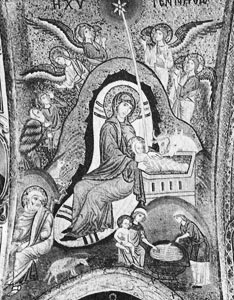
<>
Above: Mosaic of the nativity at the church of the Martorana, Palermo, 1143-51. This mosaic, on account of the delicate mosaic-work, is attributed to Greek craftsmen from Byzantium. (Curiously, the star only has 6 points). Illus. 151, Art of the Byzantine era, D. Talbot-Rice.
|
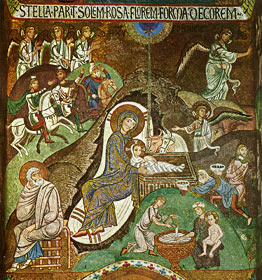 Above: Nativity, 12th century mosaic, Palatine chapel, Palermo.
Above: Nativity, 12th century mosaic, Palatine chapel, Palermo.
During the Norman rule of Sicily the Greek influence manifested itself in everything from art to architecture, and to the interest shown by the Norman court of Sicily in Greek science. The first translation of Ptolemy's Syntaxis, better known in the west as "Almagest" was made by Byzantine scholars for the Norman court of Sicily. Also translated from the Greek were Ptolemy's Optics, Euclid's Optics, Hero's Mechanica, Aristotle's Analytica Priora, and many more texts. In this mosaic appear all the greek elements: The polar void, the 8-point star (Venus), the polar axis shining its light into the Cave in which Jesus is nurtured. Illus., p.130, Byzantine Painting, André Grabar.
The mosaic above closely imitates the Greek mosaic that appears left, and includes the Greek motifs that would identify the baby Jesus to instead be the baby Zeus in the Dictaean Cave.
In less than a century (1204) the Normans sack Byzantium. Original Greek texts such as Hero's Mechanica which had been available for translation for the Normans of Sicily disappear - leaving only translations in Arabic. The descendants of these destroyers, the French, then claim that the Greeks were deficient in their capacity to understand their own heritage to appreciate it enough to know or want to preserve it. The French then attribute the preservation of Greek culture to the Arabs instead - which was passed onto them - of course - and then claim their own culture to be at the apex of European civilization. Hence we have the second period of a claimed Greek amnesia. The French have a long tradition of historical fabrication. The Gauls, conquered by the Franks, begin by claiming the name "Francia" as their own, as evidenced by the German Wipo who criticises the "Latin Franks" monopoly of the term "Frankish". (Wipo source, p. 79, Carolingian Culture, Ch. 2, Kingship and empire, J. L. Nelson). They then claim themselves to be Romans, that their progenitor was Aeneas, and thus claim to be Trojans whose achievements were "stolen" from them by the Greeks.
|
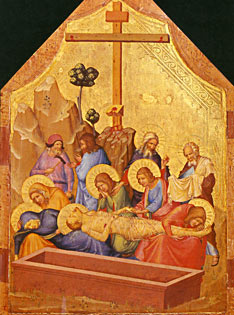 Above: Lamentation, from a diptych dating to c. 1320-50 AD, attributed to the Master of the Codex of St George. The cliffs from Byzantine illustrated manuscripts, paintings, and mosaics migrate to France. Illus. 309, The Metropolitan Museum of Art, Howard Hibbard.
Above: Lamentation, from a diptych dating to c. 1320-50 AD, attributed to the Master of the Codex of St George. The cliffs from Byzantine illustrated manuscripts, paintings, and mosaics migrate to France. Illus. 309, The Metropolitan Museum of Art, Howard Hibbard.
|
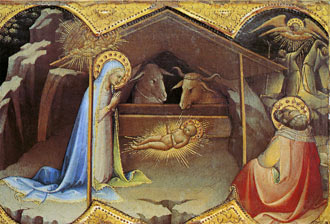 Above: Nativity, Lorenzo Monaco, by 1413. In this painting can be seen the Byzantine idea of Jesus nurtured inside earth, as was Zeus, surrounded by the cliffs that appear in Byzantine works. However, the representation is modified by the Italians who place within the cave a building within which is placed Jesus' manger. Illus. 390, The Metropolitan Museum of Art, Howard Hibbard.
Above: Nativity, Lorenzo Monaco, by 1413. In this painting can be seen the Byzantine idea of Jesus nurtured inside earth, as was Zeus, surrounded by the cliffs that appear in Byzantine works. However, the representation is modified by the Italians who place within the cave a building within which is placed Jesus' manger. Illus. 390, The Metropolitan Museum of Art, Howard Hibbard.
|
My drawing Pythia utilises the pagan elements used by Byzantine artists ostensibly to illustrate Christian ideas, but which instead express pagan concepts. I emphasise by means of my art that these are Greek (pagan) ideas and not Judaic ideas; and that my Byzantine ancestors understood theirs and my own ancestor's ancient ideas. The Classical Greeks and Byzantines did not need to write extensive tracts to explain what was self-evident to them. (Though in the case of the Byzantines, they would have had to disguise their ideas sufficiently enough so that they would not be exposed, and as a consequence, be persecuted). I though have had to write about my art because the obvious has been distorted by cultural presuppositions which cannot be supported empirically. My art is deliberate. Subsequent drawings will become increasingly "surrealised". These earlier drawings though had to demonstrate fidelity to the ideas of the past so that I may extrapolate implications from them beyond what had been intended for them by past generations.
GENERAL
contextual reasons for my choice of motifs in my 2 drawings:
The earliest mention of the Pythia in written form is found in the Levant, where the Mycenaeans, known as Philistines settled, introducing the Jews to the Greek religion, see below:
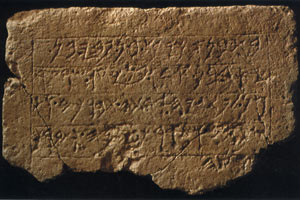 Above: Fragment of the "Ekron Royal Dedicatory Inscription" excavated from "temple 650". The inscription reads: "The temple which he built, Achish, son of Padi, son of Ysd, son of Ada, son of Ya'ir, ruler of Ekron, for Ptgyh his lady." Translated by Seymour Gitin, whose article appeared in the magazine Biblical Archaeology Review, November-December 2005, Vol. 31, no. 6.
Above: Fragment of the "Ekron Royal Dedicatory Inscription" excavated from "temple 650". The inscription reads: "The temple which he built, Achish, son of Padi, son of Ysd, son of Ada, son of Ya'ir, ruler of Ekron, for Ptgyh his lady." Translated by Seymour Gitin, whose article appeared in the magazine Biblical Archaeology Review, November-December 2005, Vol. 31, no. 6.
The Philistines though of Mycenaean origin had by the 9th century BC adopted the Semitic language, but still worshipped Greek gods.
"Aegean origins may also be indicated by the non-Semitic name of the goddess, Ptgyh, to whom the temple is dedicated. She has been associated with the sanctuary at Delphi known as Pytho, the shrine of Gaia, the Mycenaean mother-goddess.", p. 52;
"Achish, [who dedicates the temple] may be related to the name Achaean, meaning Greek, while the goddess Ptgyh is associated with the shrine at Delphi... Both names then, recall the Aegean origins of the Philistines." p. 53.
As Gitins points out, Achish/Ikausu "was the Philistine king of Gath in the times of Saul and Solomon (1 Samuel 21:11-16; 1 Samuel 27-29; 1 Kings 2:39-40)", p.52
|
The cliffs beneath which lies the cave in which baby Jesus is nurtured have a long tradition in Byzantine art. Among the earliest representations of these cliffs are the images below:
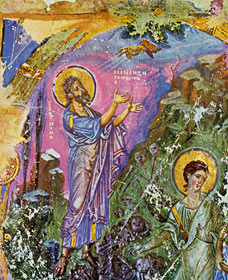 Above: Ezekeil's Vision, from the illustrated manuscript, of the Homilies of St Gregory Nazianzus, produced for emperor Basil I (867-886 AD) (MS Grec 510, Bibliotheque National, Paris). It shows the hand of god with 3 fingers and 3 rays emanating from it. Ezekeil receives his vision on the peaks nearest heaven. Illus., p.166, Byzantine Painting, André Grabar; Illus. 69, Art of the Byzantine era, D. Talbot-Rice.
Above: Ezekeil's Vision, from the illustrated manuscript, of the Homilies of St Gregory Nazianzus, produced for emperor Basil I (867-886 AD) (MS Grec 510, Bibliotheque National, Paris). It shows the hand of god with 3 fingers and 3 rays emanating from it. Ezekeil receives his vision on the peaks nearest heaven. Illus., p.166, Byzantine Painting, André Grabar; Illus. 69, Art of the Byzantine era, D. Talbot-Rice.
|
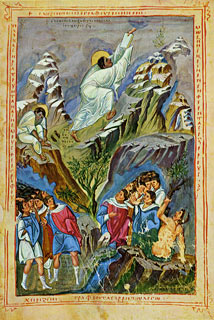 Above: Moses receiving the tablets of the law.
Above: Moses receiving the tablets of the law.
Moses receives, on a mountain summit, the "laws" of YHWH. The hand of YHWH extends from the apex of the sky. Bible of Leo the Patrician (c. 9th-10th centuries?). Vatican Library. Illus., p. 170, Byzantine Painting, André Grabar.
|
These cliffs are transmitted to both the Latin (Catholic) west and Islamic east. In the Latin west not only the Hellenised (paganised) "Christian" art was transmitted, but purely pagan art with purely Greek (pagan) ideas as well (see below):
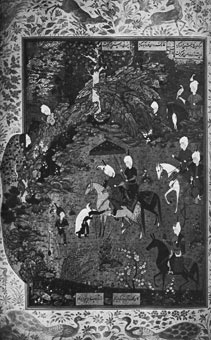 Above: Persian illustration. The background shows cliffs with caves in the Byzantine manner ascending to the sky. From the top-most cave grows a tree (the world tree?). This is Byzantine Christo-pagan setting - which has no place in Islam.
Above: Persian illustration. The background shows cliffs with caves in the Byzantine manner ascending to the sky. From the top-most cave grows a tree (the world tree?). This is Byzantine Christo-pagan setting - which has no place in Islam.
This illustration depicts Sultan Sanjar, centre on horse, from a Khasma of Nizami made for Shah Tahmasp 1539-43. Illus. 230 Islamic Art, D. Talbot-Rice.
|
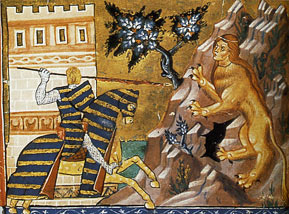 Above: Oedipus and the Sfinx from a manuscript dating to c.1286. Although the "pagan" past never disappeared in the east (Byzantium), it vanished in the west. This illustration dates to the period after the so-called Fourth Crusade of 1204, when the Catholics, claiming to be fighting on behalf of their idea of Christ, sacked Byzantium, the centre of Orthodox Christianity. In this illustration the cliffs and chasms within the cliffs which appear in Byzantine works (from at least 9th century AD) form the landscape within which dwells the sfinx (though here she is portrayed wingless). Great sculptures of sfinxes were to be found in Byzantium. These were destroyed by the Catholics in Byzantium in 1204.
Above: Oedipus and the Sfinx from a manuscript dating to c.1286. Although the "pagan" past never disappeared in the east (Byzantium), it vanished in the west. This illustration dates to the period after the so-called Fourth Crusade of 1204, when the Catholics, claiming to be fighting on behalf of their idea of Christ, sacked Byzantium, the centre of Orthodox Christianity. In this illustration the cliffs and chasms within the cliffs which appear in Byzantine works (from at least 9th century AD) form the landscape within which dwells the sfinx (though here she is portrayed wingless). Great sculptures of sfinxes were to be found in Byzantium. These were destroyed by the Catholics in Byzantium in 1204.
Choniates, the Greek/Byzantine chronicler of the sack describes their destruction: "[The Latins, after destroying the statue of Herakles and the she-wolf of Rome] did the same to the sphinxes that are comely women in the front and horrible beasts in their hind parts, that move on foot in a most bizarre manner and are nimbly borne aloft on their wings." Section 650, p.358 of the translation by H. J. Magoulias of Choniates' O City of Byzantium.
Illus. 4, p.34, Medieval Panorama, Edited by R. Bartlett.
|
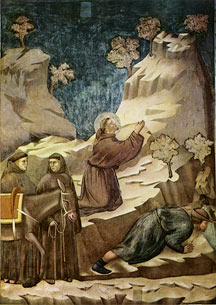 Above: The Miracle of the Spring, Giotto, c. 1297-1300. Grolier Book of Art. Volume 2, Italian Art to 1850, edited by Mario Monterverdi. S. Francesco.
Above: The Miracle of the Spring, Giotto, c. 1297-1300. Grolier Book of Art. Volume 2, Italian Art to 1850, edited by Mario Monterverdi. S. Francesco.
The Byzantine cliffs are incorporated into the art of the Italian renaissance. The cliffs in Giotto's painting are obviously modeled on the cliffs in the Byzantine manuscript depicting Moses receiving tablets of the law (pictured earlier). In Italy they became increasingly naturalistic.
|
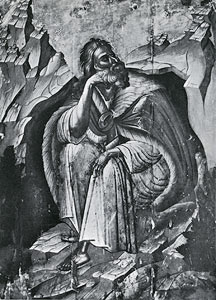 Above: Icon of the prophet Elias, 14th century AD. Byzantine Museum, Athens. Illus. 163, Byzantine painting: the last phase, D. Talbot-Rice. These are the very cliffs I have used in my drawing Pythia.
Above: Icon of the prophet Elias, 14th century AD. Byzantine Museum, Athens. Illus. 163, Byzantine painting: the last phase, D. Talbot-Rice. These are the very cliffs I have used in my drawing Pythia.
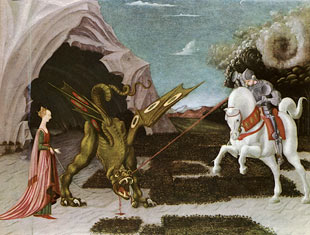
Above: St. George and the Dragon, Paolo Uccello, c. 1460. Grolier Book of Art. Volume 2, Italian Art to 1850, edited by Mario Monterverdi. National Gallery London.
The Byzantine cave in which Zeus-cum-Jesus is nurtured is here turned into the lair of the Drakon Δρακόν. Apollon who kills the Pythia at the world's navel is here re-cast as St George killing the Drakon ("dragon") which circles the polar axis. (In Greek myth it was Kadmos (Cadmus) who kills the Drakon).
|
So Hellenised (paganised) was the neo-Judaism (Christianity) of the Greek east that motifs consistent only with pre-Judaic Greek religion and not Christianity are repeatedly used, see below:
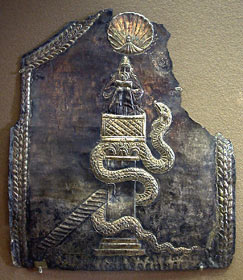 Above: Symeon Stylites on his column with a snake. Sixth century AD. Born in c. 390 AD he constructed his pillar in 412 AD and lived on it until his death 47 years later. The reliquery above is in the Louvre, Salle de Qabr Hiram. Source: http://commons.wikimedia.org/wiki/Image:Simeon_Stylite_Louvre.jpg
Above: Symeon Stylites on his column with a snake. Sixth century AD. Born in c. 390 AD he constructed his pillar in 412 AD and lived on it until his death 47 years later. The reliquery above is in the Louvre, Salle de Qabr Hiram. Source: http://commons.wikimedia.org/wiki/Image:Simeon_Stylite_Louvre.jpg
According to Evagrius Scholasticus writing in the 6th century AD:
"Symeon [was]...the first man to practice the station on a column..., who while in the flesh imitated the existence of the heavenly powers, removed himself from the affairs of the earth...And being betwixt heaven and those on the earth he conversed with God and together with the angels gave glory, from earth presenting to God requests on behalf of humans, while from heaven achieving for humans the beneficence from on high." Book 1.21, The Ecclesiastical History of Evagrius Scholasticus, p. 34 of the translation by M. Whitby.
According to L. Schachner whose article appeared in Minerva (Nov-Dec 2007, vol. 18 no. 6) the silver plate (above) is "from a reliquary depicting Symeon the Elder on top of his pillar [depicting as well]...a snake symbolising Evil." (p. 41 Minerva).
According to the Jewish (and its successor) faith(s) the serpent was the evil which caused human-kind to defy the command of god. The silver reliquary then can be interpreted thus: The heavens are closest to god, and the figure atop the pole is close to god whilst at the same time being at the greatest possible distance from the evil of earthly temptations symbolised by the snake whose purpose of existence is to mislead humanity into "error" which is defined as the defiance of the commands of the Judaic god (irrational though this god's commands are).
The idea of the pole "stylas" (στήλας) as sacred is one that is anathema to Jewish religion. In Exodus 16.14 (according to the Septuagint) the Jews on being expelled from Egypt enter the region of the "Phylistiem" (Φυλιστιέμ). Settling among these people, the Jew's god exhorts his followers to commit the following crimes:
"Thou shall not worship their gods nor serve them...but shall utterly destroy them, and break to pieces their pillars." (Septuagint, Exodus 23.24) In Exodus 34.13 (of the Septuagint) the message is reinforced: "You shall destroy their altars, and break in pieces their pillars, and you shall cut down their sacred groves, and the graven images of their gods."
(In the re-writing of the Old Testament by Jews in the 10th century AD the word "pillar" is replaced by "sacred stones".)
Finally, from the ΔΕΥΤΕΡΟΝΟΜΙΟΝ (Deuteronomy 16.21-22) again from the Septuagint:
"Do not plant for yourself a grove; you shall not plant for yourself any tree near the altar of your God. You shall not set up for yourself a pillar, which the Lord your God hates."
|
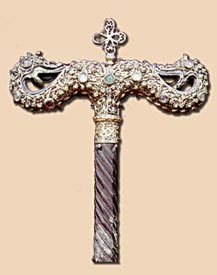 Above: Eastern greek orthodox crosier with
Above: Eastern greek orthodox crosier with
"a top comprising a pair of sculptured serpents or dragons curled back to face each other, with a small cross between them. The symbolism in the latter case is of the bronze serpents made by Moses in Numbers 21:8-9."
Quote and image source: http://www.pokimica.com/lang_en/katalog_zezla_en.htm
It is difficult to find photographs of the Greek crosier. It does not look anything like the Latin one. Although the claim is made that the idea is Biblical, it only really makes sense in the context of Greek (pagan) religion. As so many Byzantine/Greek elements that appear in the Byzantine Orthodox tradition are Greek, not Judaic, then its symbolism is most likely to be found in Greek (pagan) religion. It appears to be based on the staff of Aesclipus. Possibly it symbolises a belief that Christianity is the panacea for the soul in addition to the body?
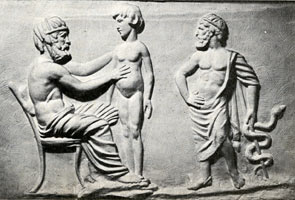
Above: Relief showing a doctor examining a youth. The scene is being overseen by Aesklipos (Aesclipus, Aesculapius), identifiable by his staff around which is entwined a snake. Illus., p. 143, Out of the Ancient World, V. Skipp. (400-300 BC?)
|
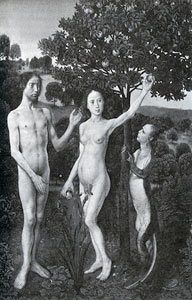 Above: Adam and Eve, van der Goes. Illus. 257, The Nude, K. Clark.
Above: Adam and Eve, van der Goes. Illus. 257, The Nude, K. Clark.
The serpent is the embodiment of evil in Jewish religion and is here tempting humanity to evil.
|
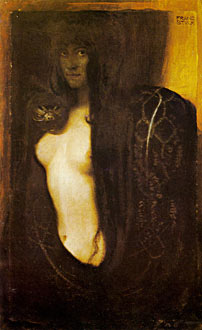 Above: German symbolist artist, Franz von Stuck's oil painting, Sin, 1893 (von Stuck, 1863-1928). Illus., p. 104, Symbolists and Symbolism, R. L. Delevoy. Another depiction of the Judaic idea of the serpent as a symbol of evil.
Above: German symbolist artist, Franz von Stuck's oil painting, Sin, 1893 (von Stuck, 1863-1928). Illus., p. 104, Symbolists and Symbolism, R. L. Delevoy. Another depiction of the Judaic idea of the serpent as a symbol of evil.
|
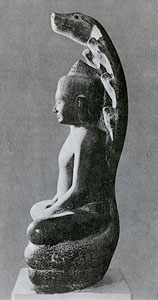 Above: Khmer, the Buddha sitting on the serpent (naga). The association here is of the serpent and the wisdom acquired by Siddartha. Angor Wat style, beginning of 12th century AD. In Indo-China Buddhist and Hindu ideas seem to merge. The Naga of the Hindu (almost) always has 7 heads (in some few representations the Naga is shown with 3 heads or 5), and here forms the throne for the central figure of Buddhism. Illus. 377, Larousse encyclopedia of Byzantine and Medieval Art. Musée Guimet, Paris.
Above: Khmer, the Buddha sitting on the serpent (naga). The association here is of the serpent and the wisdom acquired by Siddartha. Angor Wat style, beginning of 12th century AD. In Indo-China Buddhist and Hindu ideas seem to merge. The Naga of the Hindu (almost) always has 7 heads (in some few representations the Naga is shown with 3 heads or 5), and here forms the throne for the central figure of Buddhism. Illus. 377, Larousse encyclopedia of Byzantine and Medieval Art. Musée Guimet, Paris.
|
It is usually assumed by those whose cultural inheritance is Persian (Zoroastrian) and Jewish (which includes both Muslims and Christians) that any representation of a serpent is apotropaic; that is, it is intended to ward off evil. However, the serpent is beneficent and a source of wisdom in Greek religion.
In Norse mythology, when Sigurd slays the serpent ("worm") Fafnir, he acquires wisdom and can understand the utterances of birds. The association of wisdom with the snake makes its way to India where wisdom is symbolised in the form of the Naga, snake.
In the 11th and 12th centuries AD Indian ideas - both Buddhist and Hindu - suddenly spill out of India to appear as far away as Cambodia and Java (Indo-China). It is not a coincidence that the intolerant followers of Mohammed were at this time undertaking their quest to subdue India and were attempting to exterminate the polytheist Hindu.
The Buddha in the Khmer sculpture (left) sits on a serpent throne which itself is a pillar much like the Serpent Pillar of Delphi (as mentioned earlier in this essay). Symeon the Stylite is thus placed atop a pillar in a Greek (pagan) context though the symbols are misrepresented by Christians.
If the serpent is a symbol of wisdom, as it evidently is in Genesis, then Jewish religion (which includes Christianity) as well as the religion of Islam are nothing other than pseudosophies which define as a divine virtue the condition of being stupid.
|
Botticelli:
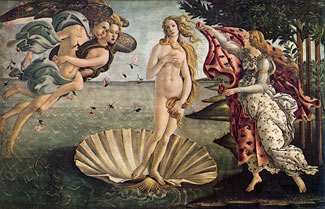 Above: The Birth of Venus, Sandro Botticelli, 1486. Grolier Book of Art. Volume 2, Italian Art to 1850, edited by Mario Monterverdi, Uffizi, Florence.
Above: The Birth of Venus, Sandro Botticelli, 1486. Grolier Book of Art. Volume 2, Italian Art to 1850, edited by Mario Monterverdi, Uffizi, Florence.
Botticelli signed his paintings ΑΛΕΧΑΝΔΡΟΣ (Alexandros=Alessandro="Sandro"), so the influence of Greek paganism is beyond dispute. In this paintings he shows Aphrodite (Venus) rising from the froth, which concurs with Hesiod's Theogony, lines 195-201, where Hesiod explains her name to mean "froth(afro)-given(dite)". Interestingly she stands on a clam shell. Clams can look like a "vagina in a shell", and when they spawn the sea turns to froth. Aphrodite (Venus) was the morning star (she was known by another name, and as a different goddess, in her "setting star" guise, but that is beyond the scope of this essay). According to the Judaic religion, she is the embodiment of evil:
"How you have fallen from heaven,
O morning star [Lucifer], son of dawn!
You have been cast down to the earth..."
Isaiah, 14.12.
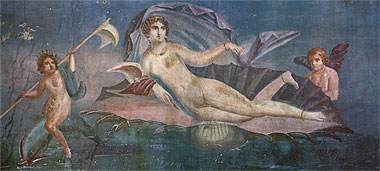
Above: Venus emerging from the surf. She sits on a clam shell. Fresco from Pompeii. Before 79 AD. Illus., p. 118-119, Imperial Rome, Great Ages of Man series, Moses Hadas
|
 Above: photograph of a clam: http://www.gadling.com/media/2006/01/Clam.JPG
Above: photograph of a clam: http://www.gadling.com/media/2006/01/Clam.JPG
|
WHY MY SFINX WEARS THE GAS MASK
Greek ideas managed
to survive the atrocities perpetrated against
those who held them by practitioners of the new
Judaic religion. Limiting this following section
to the atrocities committed against Greeks ("pagans") during the reign of Justinian as recorded by histroians who bore witness to them, Procopius and Malalas:
** "Next [Justinian] turned persecution against the 'Greeks' ["pagans"], torturing their bodies and looting their property. Many of these decided to assume for appearance' sake the name of Christian in order to avert the immediate threat; but it was not long before they were for the most part caught at their libations and sacrifices and other unholy rites." Procopius Anekdhota (translated as "The Secret History", 11.26, p.98 G.A. Williamson, Penguin);
** "Again they were bitterly hostile to the astrologers...ill-treating them simply because they were astrologers, flogging the backs of many of them and setting them on camels to be shown to jeering crowds...though they were old men and respectable in every way." (Procopius "The Secret History", 11.40, p.99 G.A. Williamson, Penguin);
** "In that year [529 AD] there was a great persecution of Hellenes [those of Greek religion: "pagans"]. Many had their property confiscated. some of them died..." (Chronicle of Malalas, Book 18.42, E. Jeffreys, M. Jeffreys, and R. Scott translation);
** "In the month of June in that indiction [561 AD] Hellenes were arrested and paraded around. their books were burnt in the kynegion, together with pictures of their loathesome gods." (Chronicle of Malalas, Book 18.136, E. Jeffreys, M. Jeffreys, and R. Scott translation);
** During the consulship of Decius [529 AD], the emperor [Justinian] issued a decree and sent it to Athens ordering that no-one should teach philosophy nor interpret the laws [of the stars]..." (Chronicle of Malalas, Book 18.47, E. Jeffreys, M. Jeffreys, and R. Scott translation) - αστρονμίαν (astro/stars nomia/laws), hence astrologers who interpret the laws of the stars.
The Deuteronomy exhorts:
" if there should be found in any one of the cities, which the Lord your God gives you, a man or a woman who shall do that which is evil...and serve other gods, and worship them, the sun or the moon, or any of the host of heaven, which he commanded you not to...[and if] this abomination has been done in Israel, then you shall bring out that man or that woman, and you shall stone them with stones, and they shall die." Deuteronomy (from Septuagint) 17.2-6.
For Greek religion to survive the noxious toxicity of Judaic religion (Christianity) it had to find some means by which it could disguise itself. That Justinian persecuted those who interpreted the laws of the stars (astologers), as well as the philosophers was because the observations of the stars (astronomy), the interpretation of the star's movements (astrologers), and the application of reason (philosophy), were all used to arrive at a definition of the divine by the Greeks. These pursuits were all part of Greek religion, and were understood as such by those not of Greek religion at that time. Plato defines philosophy as the pursuit, by means of the application of reason, of understanding the divine. To survive, Greek religion was recast. It became the observation of phenomena for their own sake and without religious conotations. The stars became, for example, a non-religious observation of the bodies in the heavens; and philosophy became the application of reason as an end in itself. When in the Greek east the holiest church was named the church of holy wisdom (Αγία Σοφία / Hagia Sofia) it was named so as a celebration of the Platonic definition of sophia (wisdom). The myths themselves were recast as fanciful and exotic fables which served only to entertain. That it is believed even to this day, that Greek philosophy was a secular pursuit, which lay outside the ambit of religion, is as good a demonstration as any, on how successful prophylaxis by means of disguise has been. Religion has not always been the celebration of ignorance as a divine command. However, those who have only ever known the faiths of Judaism, neo-Judaism (Christianity), as well as the followers of Mohammed, assume wrongly that religion has only ever been about blindly following edicts extolling as virtuous imbecilic ignorance, hate, and murder.
My Sfinx, with her prophylactic gas-mask has largely survived the toxicity.
© demetrios vakras

|

